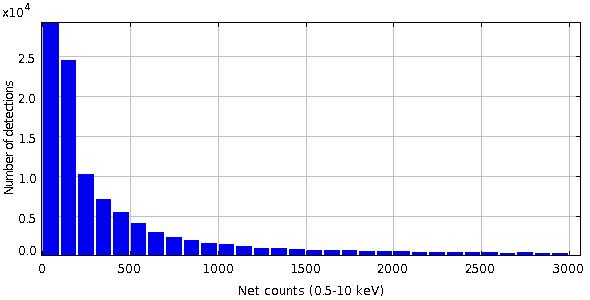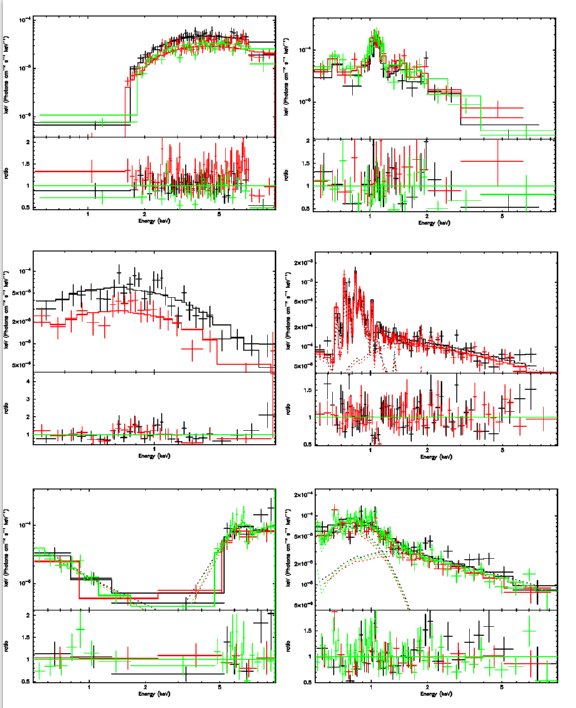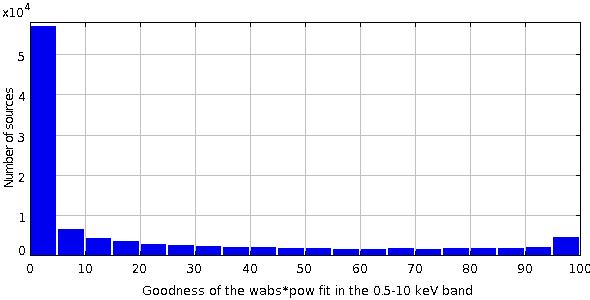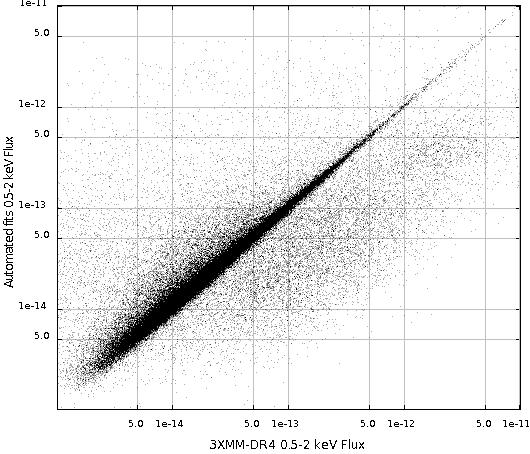Enhanced XMM-Newton Spectral-fit Database
3XMM spectral-fit database (XMMFITCAT)
Contents
1. Automated spectral fitting
The software used to perform the automated spectral fits was XSPEC 12.7.1 (Arnaud 1996). In order to obtain reliable spectral-fitting results even in the case of low-count spectra, the fitting statistics used was Cash statistics, implemented as C-stat in XSPEC. To use this statistics, grouped spectra from the CATV catalogue were ungrouped, and then grouped to 1 count per bin.
All available instruments and exposures for a single observation of a source are fitted together. All parameters for different instruments are tied together except for a relative normalisation, which accounts for the differences between different flux calibrations.
1.1. Energy bands
Three energy bands are defined to be used during the spectral fits:
- Full/Total band: 0.5-10 keV.
- Soft band: 0.5-2 keV.
- Hard band: 2-10 keV.
1.2. Spectral data selection criteria
Spectral data from the CATV catalogue were screened before applying the automated spectral-fitting pipeline so that spectral fits are only performed if the data fulfil the following criteria (depending on the model and energy band):
- Only spectra corresponding to a single instrument and observation with more than 50 counts in the total band are used in the spectral fits. This means that some detections with more than 100 EPIC counts in the total band, but less than 50 counts in each different EPIC instrument, are excluded from the automated fits, and therefore, they are not included in the spectral-fit database.
- In the case of simple models (see Sect.1.3), they are only applied if the number of EPIC counts (all instruments added together) is larger than 50 counts in the energy band in which the model is applied. This means that some detections can lack spectral-fitting results in the soft and/or hard bands if the number of EPIC counts in the full band was larger than 50 counts but lower than that value in the soft and/or hard bands.
- Complex models (see Sect.1.3), are only applied if the number of EPIC counts is larger than 500 counts in the total band, and larger than 50 counts in the soft and hard bands.
As a result of the application of these criteria, the spectral-fit database contains spectral-fitting results corresponding to the simple models in the full band for CATD source detections, and it contains spectral-fitting results in the soft and hard bands for CATD and CATD source detections, respectively. Spectral-fitting results for complex models are available for CATD source detections. The distribution of spectral counts per observation used during the automated fits is plotted in Fig. 1. Observations with more than 3000 counts, 10% of the CATD detections, are excluded of this plot for clarity.
 Figure 1. Distribution of net counts (background subtracted spectral counts) per observation used in the automated spectral fits. Observations with more than 3000 counts are not included in this plot.
Figure 1. Distribution of net counts (background subtracted spectral counts) per observation used in the automated spectral fits. Observations with more than 3000 counts are not included in this plot.
1.3. Spectral models
The spectral models implemented in the construction of this database were selected according to the most common spectral shapes displayed by different astronomical sources, but no information about the source type or redshift is used during the spectral fits. There are six different models, three simple and three more complex models, as follows:
- Simple models:
- Absorbed power-law model (XSPEC: wabs*pow): this model is applied in the total, soft, and hard energy bands. Variable parameters are the hydrogen column density of the absorber, the power-law photon index, and the power-law normalisation
- Absorbed thermal model (XSPEC: wabs*mekal): this model is applied in the total, and soft bands. Variable parameters are the hydrogen column density of the absorber, the plasma temperature of the thermal component, and the normalisation of the thermal component.
- Absorbed black-body model (XSPEC: wabs*bb): this model is applied in the soft band. Variable parameters are the hydrogen column density of the absorber, the black-body temperature, and the normalisation of the black-body.
- Complex models: only applied in the total energy band.
- Absorbed thermal plus power-law model (XSPEC: wabs*(mekal+wabs*pow)). Variable parameters are the hydrogen column density of both absorbers, the plasma temperature, the photon index, and the normalisation of the power-law and thermal components.
- Absorbed double power-law model (XSPEC: wabs*(pow+wabs*pow)): Variable parameters are the hydrogen column density of both absorbers, the photon indices of both power-law components, and their normalisations.
- Absorbed black-body plus power-law model (XSPEC: wabs*(bb+pow)). Variable parameters are the hydrogen column density of the absorber, the black-body temperature, the power-law photon index, and the normalisations.
The range of values allowed for the parameters are:
- Hydrogen column density: 1020 - 1024 cm-2.
- Power law photon index: 0 - 4.
- Thermal plasma temperature: 0.08 - 20 keV.
- Black-body temperature: 0.01 - 10 keV.
Examples of automated spectral fits for each of the spectral models used are plotted in Fig. 2. The distribution of photon indices for the detections for which an absorbed power-law model is an acceptable fit, >70% of the detections (see Sect.1.5), is shown in Fig. 3. Frozen photon indices (see Sect.1.4) are excluded from this plot.
 Figure 2. Examples of spectral fits for the six different models applied. Plots correspond to the unfolded spectra and model over data to model ratio. From left to right and top to bottom: wabs*pow, wabs*mekal, wabs*bb, wabs(mekal+wabs*pow), wabs(pow+wabs*pow), and wabs(bb+pow).
Figure 2. Examples of spectral fits for the six different models applied. Plots correspond to the unfolded spectra and model over data to model ratio. From left to right and top to bottom: wabs*pow, wabs*mekal, wabs*bb, wabs(mekal+wabs*pow), wabs(pow+wabs*pow), and wabs(bb+pow).
 Figure 3. Photon index distribution corresponding to the detections for which an absorbed power-law model in the full band is an acceptable fit.
Figure 3. Photon index distribution corresponding to the detections for which an absorbed power-law model in the full band is an acceptable fit.
1.4. Error computation
Errors for all variable parameters are computed at the 90% confidence level. If the error computation hits the lower and upper limits, the parameter is fixed. The values the parameters are fixed to depend on the model, energy band, and data quality, and they were selected so as to optimise the spectral-fitting process.
In the case of simple models and the power-law, thermal or black body components, the parameter is fixed to the value obtained by removing the absorption component and fitting the resulting model in the hard (in the case of the power-law model), or the soft (in the case of the thermal and black-body models) bands. If the number of counts in the soft or hard band is lower than 20 counts, or the fit is being performed in the soft band in the case of a power-law model, the photon index is fixed to 2, the plasma temperature to 1 keV, and the black-body temperature to 0.1 keV.
In the case of the absorption component in simple models, the value is obtained by fixing the photon index or the temperature (depending on the model), and fitting the resulting model. If the number of counts in the hard or soft band is lower than 20 counts, the parameter is fixed to 1020 or 1022 cm-2, respectively.
In the case of complex models, the parameters are fixed to the values obtained from the simple models in the energy band most relevant for the spectral component under consideration. For example, in the case of the soft power-law component in the double power-law model, the photon index would fixed to the value obtained from the absorbed power-law fit in the soft band.
1.5. Goodness of fit
Since Cash maximum likelihood statistics lacks an estimate of goodness of fit, the XSPEC command goodness is used. This command performs a number of simulations, 1000 simulations were selected for this database, and returns the percentage of simulations that gives a lower value of the statistic. In this way, if a model returns a N% goodness value, the model can be rejected at the N% confidence level. As an example, the distribution of goodness values obtained for the power-law fit in the full band are plotted in Fig. 4. Taking into account all the spectral models implemented in this database, an acceptable fit, defined by a value of goodness <50%, is found for 82% of all the detections.
 Figure 4. Goodness distribution of the WAPO model.
Figure 4. Goodness distribution of the WAPO model.
An estimated value for the reduced χ2 is also provided in the database. This value is obtained by changing the fitting statistics to χ2 after performing the spectral fit. Both estimates, goodness and reduced χ2, can be used to compare different models so as to decide which one is a better representation of the data. However, those values cannot provide a probability that a model is the correct one (see XSPEC documentation about the implemented statistics for more details).
2. Description of the columns
The spectral-fit database contains one row for each detection, and 214 columns containing information about the source detection and the spectral-fitting results. Not available values are represented by a "-99" value. The first 12 columns contain information about the source and observation, whereas the remaining 202 columns contain, for each model applied, model spectral-fit flags, parameter values and errors, fluxes, and four columns to describe the goodness of the fit.
2.1 Source and observation
IAUNAME: The IAU name assigned to an unique source in the CATV catalogue.
SRCID: A unique number assigned to a group of catalogue entries which are assumed to be the same source in CATV.
DETID: A consecutive number which identifies each entry (detection) in the CATV catalogue.
OBS_ID: The XMM-Newton observation identification, as in CATV.
SRC_NUM: The (decimal) source number in the individual source list for this observation (OBS_ID), as in CATV.
SRC_HEX: Source number expressed in the hexadecimal system to identify the source-specific product files belonging to this detection.
SC_RA, SC_DEC: Right ascension and declination in degrees (J2000) of the unique source, as in the CATV catalogue. RA and DEC correspond to the SC_RA and SC_DEC columns in the CATV catalogue. These are corrected source coordinates and, in the case of multiple detections of the same source, they correspond to the weighted mean of the coordinates for the individual detections.
T_COUNTS/H_COUNTS/S_COUNTS: spectral background subtracted counts in the full/hard/soft bands computed by adding all available instruments and exposures for the corresponding observation. A number of counts equal to -99 means that the number of counts is < 50 counts and the spectral fit in that band is not performed.
GNH: Galactic column density in the direction of the source from the Leiden/Argentine/Bonn (LAB) Survey of Galactic HI.
2.2 Model related columns
Columns referring to any particular model start with the model's name. Model names are:
WAPO: absorbed power-law model applied in the full band.
WAPOS: absorbed power-law model applied in the soft band.
WAPOH: absorbed power-law model applied in the hard band.
WAMEKAL: absorbed thermal model applied in the full band.
WAMEKALS: absorbed thermal model applied in the soft band.
WABBS: absorbed black-body model applied in the soft band.
WAMEKALPO: absorbed thermal plus power-law model applied in the full band.
WAPOPO: absorbed double power-law model applied in the full band.
WABBPO: absorbed black-body plus power-law model applied in the full band.
2.2.1 Spectral-fit summary columns
The first two columns after the columns related to the source and observation, are A_FIT, and P_MODEL.
A_FIT: The value is set to True, if an acceptable fit, i.e. goodness value < 50%, has been found for the models applied in the full band, and to False otherwise.
P_MODEL: The data preferred model, i.e., the simplest spectral model with the lowest goodness value among the models applied in the full band. Each model is assigned a number as follows:
- 0: WAPO.
- 1: WAMEKAL.
- 2: WABBPO.
- 3: WAMEKALPO.
- 4: WAPOPO.
In the case of different models with equal goodness values, the preferred model is selected preferentially in the same numerical order assigned to the models, from 0 to 4. A spectral model is always listed regardless of the fit being an acceptable or an unacceptable fit. IMPORTANT NOTE: This column is only aimed to provide the user with a simplified description of the spectral shape, and it must not be considered as a best-fit model.
The remaining columns refer to the spectral-fitting results for the different models applied. The first column for each model is called MODEL_FIT, and it contains information about the spectral fit for that particular model. The possible values for this column correspond to the different situations that may occur during the spectral fits, and they are described as follows:
- 0: The spectral fit was performed, and the model is considered an acceptable fit, i.e, the value returned by the command goodness is lower than 50%.
- 1: The spectral fit was performed, but the value returned by the command goodness is greater than 50%.
- 2: The spectral fit was not performed because the number of counts in the soft band is lower than 50 counts.
- 3: The spectral fit was not performed because the number of counts in the hard band is lower than 50 counts.
- 4: The complex-model spectral fit was not performed because the number of counts in the full band is lower than 500 counts.
- 5: Complex-model fit results not reported because soft model component (thermal or black-body) is not significant, i.e., its normalisation is consistent with 0 at the 90% confidence level.
- 6: Complex-model fit results not reported because hard model component (power-law) is not significant, i.e., its normalisation is consistent with 0 at the 90% confidence level.
- 7: No best-fit parameters found. This may occur if the allowed ranges for the parameters to vary and/or the spectral model are not a good representation of the data, and XSPEC falls into an infinite loop.
2.2.2 Parameters and errors
Columns referring to parameters and errors start with the model name and the parameter name. Possible parameters names are: NH (wabs column density, in units of 1022 cm-2), GAMMA (power-law photon index), KT (mekal or black-body temperature, in keV), and NORM (normalisation of the component). For every variable parameter, except for the normalisation for which only best-fit values and errors are reported, there are four columns:
MODEL_PARAMETER: parameter value.
MODEL_PARAMETER_HI, MODEL_PARAMETER_LO: upper and lower errors (at the 90% confidence level). In the case of fixed parameters, the error values are equal to -99.
MODEL_PARAMETER_ERR: Flag on the parameter error calculation. The different flags are:
- 0: no errors occurred during the parameter error computation.
- 1: parameter error computation hit hard lower/upper limit.
- 2: parameter fixed to the value computed in the soft band by using a simple model.
- 3: parameter fixed to the value computed in the hard band by using a simple model.
- 4: parameter fixed to its initial value.
2.2.3 Fluxes
For each model, the flux and its errors at the 90% confidence level are computed in the energy band of the spectral fit. Reported fluxes correspond to EPIC fluxes, i.e., in the case of multiple instrument spectra for a single observation, the reported flux is the average of the different fluxes for each instrument and exposure. EPIC soft fluxes obtained from the spectral fits are plotted against the ones in the 3XMM-DR4 catalogue in Fig. 5. The spectral model used to derive the fluxes in the case of the automated fits wasthe model applied in the soft band with the lowest value of goodness. Fluxes from the automated fits and from the 3XMM-DR4 are consistent within errors for ∼70% of the detections. Significant differences between both values are more frequent among sources displaying a soft spectrum, i.e., those sources that are best-fitted by a power-law with a steep photon index, or by a thermal model. More than 80% of the non-matching fluxes correspond to any of these cases.
MODEL_FLUX: the mean observed flux (in erg cm-2 s-1) of all instruments and exposures for the corresponding observation, in the energy band used in the spectral fit.
MODEL_FLUX_HI, MODEL_FLUX_LO: flux errors.
 Figure 5. Soft fluxes (in c.g.s. units) computed from the automated fits against fluxes in the 3XMM-DR4 catalogue.
Figure 5. Soft fluxes (in c.g.s. units) computed from the automated fits against fluxes in the 3XMM-DR4 catalogue.
2.2.4 Fitting statistics
MODEL_CSTAT: C-stat value.
MODEL_DOF: Degrees of freedom.
MODEL_REDCHI: Reduced χ2 from the C-stat fitting.
MODEL_GOODNESS: Return value of the command goodness in XSPEC.
© Copyright IAASARS/NOA | Courtesy of Open Web Design | A. Ruiz, webmaster
